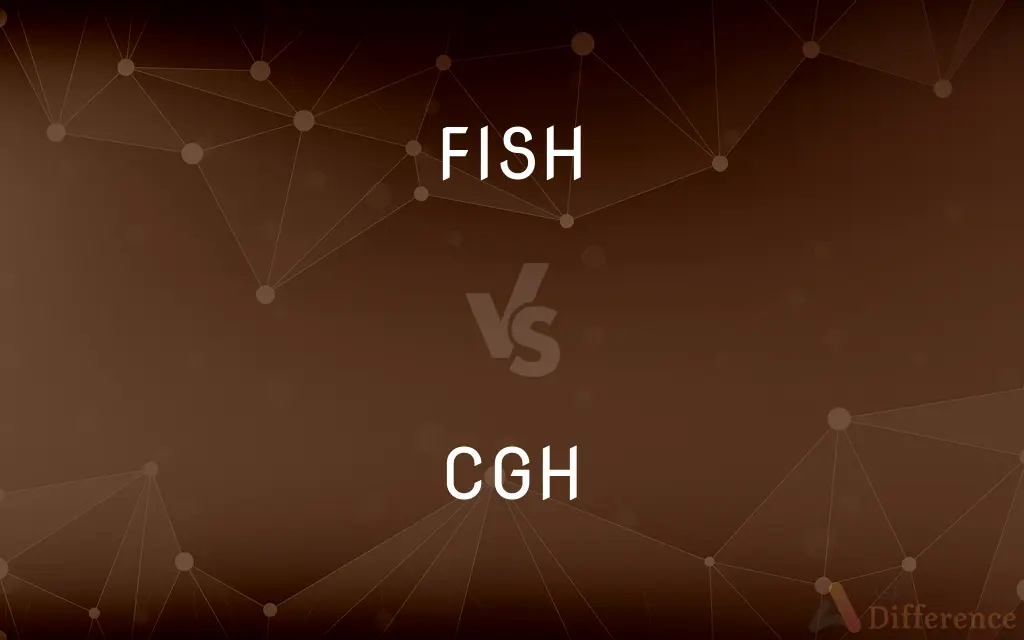FISH vs. CGH — What's the Difference?
By Fiza Rafique & Urooj Arif — Published on February 20, 2024
FISH (Fluorescence In Situ Hybridization) locates specific DNA sequences on chromosomes. CGH (Comparative Genomic Hybridization) compares genomic content to detect variations.

Difference Between FISH and CGH
Table of Contents
ADVERTISEMENT
Key Differences
FISH (Fluorescence In Situ Hybridization) and CGH (Comparative Genomic Hybridization) are both molecular cytogenetic techniques used to analyze genetic variations and abnormalities. FISH utilizes fluorescent probes that bind to specific DNA sequences on chromosomes, allowing for the visualization of genetic abnormalities, such as deletions, duplications, translocations, and the presence of extra chromosomes. This technique is highly specific and can be used to target specific regions within the genome, making it invaluable in diagnosing genetic diseases, identifying specific pathogens in infections, and in cancer research.
CGH, on the other hand, compares the genomic content of a test sample with a reference sample to identify genomic variations without the need for specific probes. This technique involves labeling test and reference DNA with different fluorescent dyes, co-hybridizing them to a normal metaphase chromosome spread or a microarray, and analyzing the ratio of the fluorescent signals. CGH is particularly useful for detecting unbalanced chromosomal abnormalities across the entire genome, such as gains or losses of chromosome material, but it does not detect balanced rearrangements or the precise location of DNA sequence alterations.
While FISH provides precise localization of genetic changes on chromosomes, CGH offers a broader overview of genomic imbalances between two genomes. FISH's strength lies in its ability to pinpoint specific genetic markers within a complex genome, useful in targeted diagnostics and research. CGH's advantage is its genome-wide screening capability, making it ideal for identifying unknown genetic abnormalities and for comparative genomic studies.
Both FISH and CGH have transformed genetic analysis, each with its unique applications. FISH's ability to visually map the genetic landscape of individual cells offers detailed insights into genetic disorders, while CGH's comparative approach is invaluable in detecting and cataloging genomic variations on a broader scale. Together, these techniques provide powerful tools for understanding the genetic basis of diseases and for developing targeted genetic therapies.
FISH and CGH represent complementary approaches to genetic analysis. FISH is highly specific and localized, ideal for detailed chromosomal examinations, whereas CGH provides a comprehensive view of genomic alterations without the need for prior knowledge of specific genetic targets. The choice between FISH and CGH depends on the research or diagnostic goals, with each method offering distinct benefits in the field of genetic analysis.
ADVERTISEMENT
Comparison Chart
Technique
Uses fluorescent probes to bind specific DNA sequences
Compares genomic content to detect variations
Application
Diagnosing genetic diseases, cancer research
Genome-wide screening for abnormalities
Specificity
High, targets specific regions
Broad, scans entire genome
Detection
Visualizes location of genes/chromosomal regions
Identifies gains or losses of chromosome material
Limitations
Requires knowledge of target sequences
Cannot detect balanced rearrangements
Compare with Definitions
FISH
Identifies genetic abnormalities in cells.
FISH was used to detect the deletion causing the genetic disorder.
CGH
Compares genomic DNA to identify variations.
CGH was instrumental in uncovering genomic gains in the tumor sample.
FISH
A technique to visualize specific DNA sequences.
FISH revealed the translocation of chromosomes in the patient's cells.
CGH
Detects unbalanced chromosomal abnormalities.
The CGH analysis showed a significant loss of chromosomal material.
FISH
Applicable in cancer diagnosis and genetics.
FISH analysis confirmed the presence of a cancer-specific genetic marker.
CGH
Suitable for genome-wide screening.
We utilized CGH to screen for abnormalities across the entire genome.
FISH
Uses fluorescent probes for targeted analysis.
The fluorescent probes in FISH made it easy to locate the gene of interest.
CGH
Uses fluorescent labeling for comparison.
Differential fluorescent labeling in CGH highlighted genomic imbalances.
FISH
Can determine the presence of pathogens.
FISH helped identify the bacterial pathogen directly in the tissue sample.
CGH
Does not require specific sequence knowledge.
CGH allowed us to identify genetic variations without prior sequence data.
Common Curiosities
Can FISH detect all types of chromosomal abnormalities?
FISH is excellent for detecting numerical and some structural abnormalities but may not detect balanced translocations.
What is FISH used for?
FISH is used for pinpointing the location of specific DNA sequences on chromosomes.
How does CGH work?
CGH compares the genomic content of test and reference samples to identify variations.
Which is better for detecting cancer mutations, FISH or CGH?
Both can be used, but FISH is often preferred for its specificity in identifying known cancer-related genetic abnormalities.
Can FISH be used on non-dividing cells?
Yes, FISH can be applied to both dividing and non-dividing cells.
How long does a FISH analysis take?
FISH results can often be obtained within a day, depending on the complexity.
Is CGH useful in prenatal testing?
Yes, CGH can be used for prenatal screening of chromosomal abnormalities.
Is CGH capable of identifying gene mutations?
CGH identifies gains and losses of chromosomal material but not point mutations.
What types of samples can be analyzed by CGH?
CGH can analyze DNA from any source, including blood, tissue, and tumors.
What advancements have been made in FISH technology?
Developments include multiplex FISH, which allows for the simultaneous detection of multiple targets.
Can non-ionic surfactants be used in both FISH and CGH preparations?
Yes, non-ionic surfactants can be used in sample preparations for both techniques to improve hybridization efficiency.
What are the limitations of FISH?
FISH requires prior knowledge of the genetic sequences to be targeted.
How does CGH differ from traditional karyotyping?
CGH provides a higher resolution view of genomic copy number variations without the need for metaphase chromosomes.
How has CGH contributed to understanding genetic diseases?
CGH has enabled the discovery of previously undetectable chromosomal imbalances associated with various genetic conditions.
Are FISH and CGH compatible with next-generation sequencing (NGS)?
While FISH and CGH are distinct from NGS, they can complement NGS data by providing structural and copy number variation information.
Share Your Discovery

Previous Comparison
Copper 1 vs. Copper 2
Next Comparison
Love vs. True LoveAuthor Spotlight
Written by
Fiza RafiqueFiza Rafique is a skilled content writer at AskDifference.com, where she meticulously refines and enhances written pieces. Drawing from her vast editorial expertise, Fiza ensures clarity, accuracy, and precision in every article. Passionate about language, she continually seeks to elevate the quality of content for readers worldwide.
Co-written by
Urooj ArifUrooj is a skilled content writer at Ask Difference, known for her exceptional ability to simplify complex topics into engaging and informative content. With a passion for research and a flair for clear, concise writing, she consistently delivers articles that resonate with our diverse audience.
















































